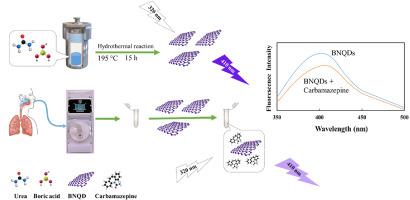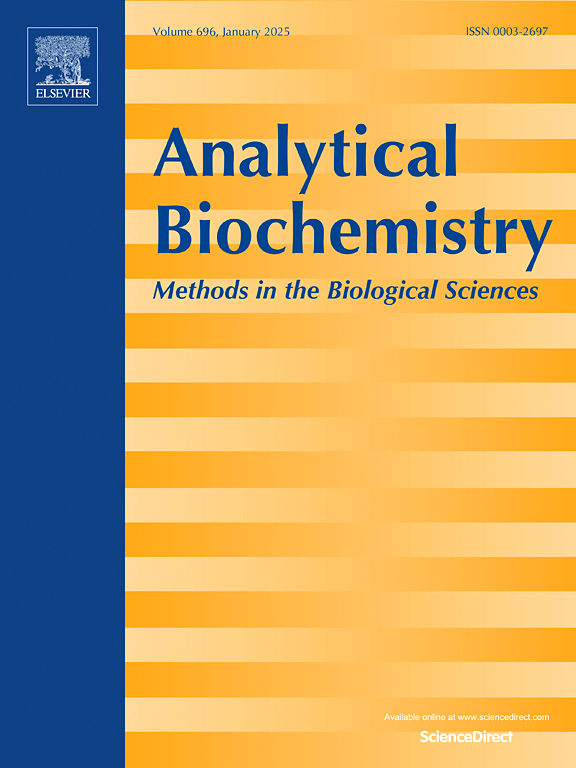氮化硼量子点荧光传感器测定呼出液中卡马西平
IF 2.5
4区 生物学
Q2 BIOCHEMICAL RESEARCH METHODS
引用次数: 0
摘要
卡马西平是一种广泛使用的抗癫痫药物,治疗指标较窄,需要精确监测,以避免毒性,确保治疗效果。本研究提出了一种利用氮化硼量子点(BNQDs)的荧光纳米传感器,用于快速灵敏地检测呼出液(EBC)中的卡马西平。采用简单的水热法制备了BNQDs,并利用透射电子显微镜、动态光散射、能量色散x射线和衰减全反射-傅里叶变换红外技术对其进行了表征。该传感器在卡马西平的作用下BNQD荧光猝灭具有浓度依赖性,线性响应范围为0.2 ~ 2.4 μ mL−1,低检出限为0.05 μ mL−1。Stern-Volmer分析证实了动态淬火机制。该纳米传感器还显示出对常见药物的高选择性,并成功应用于卡马西平治疗患者的真实EBC样本。这种基于bnqd的传感平台为卡马西平的无创治疗药物监测提供了一种快速、经济、用户友好的方法。本文章由计算机程序翻译,如有差异,请以英文原文为准。

Boron nitride quantum dot-based fluorescent sensor for carbamazepine determination in exhaled breath condensate
Carbamazepine is a widely prescribed antiepileptic drug with a narrow therapeutic index, necessitating precise monitoring to avoid toxicity and ensure therapeutic efficacy. This study presents a fluorescence-based nanosensor using boron nitride quantum dots (BNQDs) for the rapid and sensitive detection of carbamazepine in exhaled breath condensate (EBC). BNQDs were prepared via a simple hydrothermal technique and characterized using transmission electron microscopy, dynamic light scattering, energy-dispersive X-ray, and attenuated total reflectance-Fourier transform infrared techniques. The sensor exhibited a concentration-dependent quenching of BNQD fluorescence upon carbamazepine addition, with a linear response range of 0.2–2.4 μg mL−1 and a low detection limit of 0.05 μg mL−1. Stern–Volmer analysis confirmed a dynamic quenching mechanism. The nanosensor also demonstrated high selectivity against common co-administered drugs and was successfully applied to real EBC samples collected from patients receiving carbamazepine therapy. This BNQD-based sensing platform offered a rapid, cost-effective, and user-friendly approach for the non-invasive therapeutic drug monitoring of carbamazepine.
求助全文
通过发布文献求助,成功后即可免费获取论文全文。
去求助
来源期刊

Analytical biochemistry
生物-分析化学
CiteScore
5.70
自引率
0.00%
发文量
283
审稿时长
44 days
期刊介绍:
The journal''s title Analytical Biochemistry: Methods in the Biological Sciences declares its broad scope: methods for the basic biological sciences that include biochemistry, molecular genetics, cell biology, proteomics, immunology, bioinformatics and wherever the frontiers of research take the field.
The emphasis is on methods from the strictly analytical to the more preparative that would include novel approaches to protein purification as well as improvements in cell and organ culture. The actual techniques are equally inclusive ranging from aptamers to zymology.
The journal has been particularly active in:
-Analytical techniques for biological molecules-
Aptamer selection and utilization-
Biosensors-
Chromatography-
Cloning, sequencing and mutagenesis-
Electrochemical methods-
Electrophoresis-
Enzyme characterization methods-
Immunological approaches-
Mass spectrometry of proteins and nucleic acids-
Metabolomics-
Nano level techniques-
Optical spectroscopy in all its forms.
The journal is reluctant to include most drug and strictly clinical studies as there are more suitable publication platforms for these types of papers.
 求助内容:
求助内容: 应助结果提醒方式:
应助结果提醒方式:


